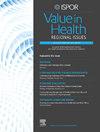Valuation of EQ-5D Health States for Adults in Low-, Lower-Middle, and Upper-Middle-Income Countries: A Systematic Review
IF 1.5
Q3 HEALTH CARE SCIENCES & SERVICES
引用次数: 0
Abstract
Objectives
Preference-based measurement of health-related quality of life is crucial for informing resource allocation decisions, with the EQ-5D instrument widely used as a measure of health-related quality of life. Although country-specific value sets are well established in many high-income countries, current summarized evidence from valuation studies in low- and middle-income countries (LMICs) remains limited. This review systematically identified EQ-5D valuation studies in LMICs, summarized methodologies and scoring algorithms by country type, and highlighted key challenges.
Methods
A systematic search was undertaken across 7 academic databases and the EuroQol website. Two independent reviewers screened titles and abstracts and performed full-text reviews and data extraction. Reporting followed Checklist Reporting Valuation Studies of Multi-Attribute Utility-Based Instruments for quality assessment. The synthesis included study characteristics, methodologies, and summarized scoring algorithms from the best-performing models, highlighting variations across countries.
Results
Through screening 9378 studies, 35 studies from 22 LMICs were included. Of these, 20 (58%) were from upper-middle-income countries, whereas low-middle and low-income countries accounted for 13 (37%) and 2 (6%) studies, respectively. Eighteen (51%) studies reported EQ-5D-5L valuations. Sample sizes ranged from 148 to 5503, with the time trade-off method being predominant. Scoring algorithms showed no significant variation between upper-middle- and low-middle-income countries, except for the pain/discomfort dimension in EQ-5D-5L. Mobility was the most reported utility decrement among studies.
Conclusions
There is a growing trend in developing country-specific value sets in LMICs. Contextually relevant designs and adequate pilot studies could enhance the accuracy of value sets in culturally diverse settings, particularly where severe health states are commonly reported.
对低收入、中低收入和中高收入国家成人EQ-5D健康状态的评估:一项系统综述
目标:基于偏好的健康相关生活质量测量对于为资源分配决策提供信息至关重要,EQ-5D仪器被广泛用作健康相关生活质量的测量。虽然在许多高收入国家已经建立了具体国家的价值集,但目前在低收入和中等收入国家(LMICs)进行的估值研究总结的证据仍然有限。本综述系统地确定了中低收入国家的EQ-5D评估研究,按国家类型总结了方法和评分算法,并强调了主要挑战。方法:系统检索7个学术数据库和EuroQol网站。两名独立审稿人筛选标题和摘要,并进行全文审查和数据提取。报告遵循清单报告评估研究多属性实用工具的质量评估。综合包括研究特征、方法,并总结了表现最好的模型的评分算法,突出了各国的差异。结果:共筛选9378项研究,纳入22个低收入国家的35项研究。其中,20项(58%)研究来自中高收入国家,而中低收入和低收入国家分别占13项(37%)和2项(6%)研究。18项(51%)研究报告了EQ-5D-5L的估值。样本量从148到5503不等,时间权衡法占主导地位。评分算法显示,除了EQ-5D-5L的疼痛/不适维度外,中高收入国家和中低收入国家之间没有显著差异。在所有研究中,流动性是报告最多的效用递减。结论:在中低收入国家中,发展中国家特有的价值设置有日益增长的趋势。与环境相关的设计和充分的试点研究可以提高文化多样化环境中价值设定的准确性,特别是在普遍报告严重健康状况的情况下。
本文章由计算机程序翻译,如有差异,请以英文原文为准。
求助全文
约1分钟内获得全文
求助全文
来源期刊

Value in health regional issues
Pharmacology, Toxicology and Pharmaceutics-Pharmacology, Toxicology and Pharmaceutics (miscellaneous)
CiteScore
2.60
自引率
5.00%
发文量
127
 求助内容:
求助内容: 应助结果提醒方式:
应助结果提醒方式:


